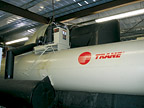Today, the center's mission is to develop and promote state-of-the-art health care services and programs dedicated to enhancing the health and well being of the people of Hawaii, the Pacific Basin, and Pacific Rim.
In 2002, the Kapi`olani Medical Center at Pali Momi, Pearlridge was added, thereby extending its care offering to men as well as women and children. This 116-bed, acute-care facility in Oahu's growing Leeward area annually admits approximately 5,500 patients and performs 1,800 inpatient and 4,500 outpatient surgeries. In 2003, there were 65,000 outpatient visits and 23,000 emergency room visits.

Patient Care Beyond the Patient
While the medical and nursing staff fulfills the commitment to "Kulia I Ka Nu'u," facility administrators are similarly dedicated to providing the most up-to-date equipment necessary to deliver that same level of care. That includes maintaining the buildings themselves, providing auxiliary services (kitchen-laundry) as well as providing a comfortable, healing environment.Weather on the Oahu Island is very consistent with only moderate changes in temperature throughout the year. The average daytime summer temperature at sea level is 85°F (29.4°C). The average daytime winter temperature is 78° (25.6°C). Nighttime temperatures are approximately 10° lower. Because of this consistently warm weather pattern and the high cost of energy in Hawaii, it is imperative that the facility be cooled effectively, reliably, and economically.
According to the Western Area Power Association, hospitals are known to incur extremely high utility costs. The average energy use, when measured on a per-square-foot basis, varies with the age and type of facility, number of beds, laundry use, emergency and intensive care, surgical operation, kitchen use, etc. However, historical data shows that hospitals use anywhere from a low of 200,000 Btu/sq ft/yr to more than 500,000 Btu/sq ft/yr, with the median energy use being about 350,000.
The EPA further notes that the nation's hospitals annually spend nearly $3 billion on electricity alone, consuming nearly 50 billion kWh. Energy costs can easily account for as much as 8% of a hospital's overall operating expenses, experts say. If U.S. hospitals were to improve their energy efficiency by an average of 30%, a goal well within the reach of most facilities, they would save nearly $1 billion annually, according to industry experts. That would not only lower the overall cost of health care, but it would also provide the same environmental relief as taking more than 2 million cars off the road, due to lowered carbon dioxide emissions, a byproduct of energy production.
The DOE notes on its website: "Medical facilities are one of the most energy intensive building types, using energy at twice the rate of office space and three times the rate of schools."
"Since 1971 when they were first installed, Kapi`olani had been cooled using two 350 ton (R-11) and one 300 ton (R-11) chilled water systems," according to project developer Ray Starling of Off-Peak/Elite Energy, LLC. "So in 2001, when the center's thirty-year-old dual chilled water system began showing its age by showing significant operational and maintenance problems, it was clear that the time was right to review and overhaul the entire cooling operation."
The Decision for OPC
After a lengthy review process by the Kapi`olani administrative review board, it was decided to replace the two aging chiller systems with a new, centrally located TES system. According to John Henderson of Sodexho, the general contractor, the reasons behind the decision were four-fold: experience, economics, efficiency, and the environment."The decision, however, was not without apprehension," according to Tom Nishi, the mechanical contractor from Elite Mechanical. "The administrators were tentative by lack of familiarity with the technology, lack of space in which to put the tanks, and lack of understanding of the environmental impact of OPC."
That anxiety was diminished by Sodexho's guarantee of energy cost savings. "We do that with every job," Henderson added. "We've yet to write a check."
The D-B Team
Sodexho is an international company serving 1,400 U.S. hospitals with engineering, housekeeping, and food services. In its role as engineers at Kapi`olani, Sodexho initiated the HVAC renovation undertaking. Sodexho has extensive experience putting together effective D-B teams to develop a viable plan. In this case, the team consisted of the developer, mechanical engineers, design engineers, electrical engineers, contractors, and civil/structural engineers.The chosen team had vast experience with both conventional cooling installations as well as with TES or off-peak cooling (OPC). OPC is a cooling technology that calls for ice to be produced at night in thermal storage tanks. That ice is used during the day to cool the interior space of a building. The team presented a plan for both options to the center's administration.
"We know the importance of keeping patients comfortable," said Henderson. "That's why we had to make sure that whatever system was finally selected, it not only had to perform reliably, but it had to be energy efficient as well." In health care buildings, healthy indoor air is crucial for patient care as well as for the proper functioning of humidity-sensitive processes such as microelectronics, photography, printing, and archiving.
Furthermore, whereas under ordinary conditions a system shutdown for system turnovers would take several hours or even days, hospitals cannot not afford this luxury. "Our system shutdown lasted only about three hours, from midnight to 3 a.m.," added Henderson. "Hardly anyone noticed."
Good Fences Make Better Neighbors
On the matter of lack of available space in which to situate the TES tanks, the team was conducting a thorough survey of the center's grounds when it happened upon a 10-ft wide and 125-yard long strip of unused land between the facility and a neighboring church. That strip was large enough to accommodate 31 thermal storage tanks.Although the church found no objection to the tanks' installation, the D-B team nonetheless made it an offer that was hard to turn down. The team offered to erect a fence to conceal the tanks, as well as to air condition the church, which also serves as a nursery school during the day.
Church officials were delighted with the offer and even supported the zoning variance that was needed in order for this project to materialize.
The System
The new system consisted of a 600-ton Trane ice (glycol) chiller (R-123) and an 850-ton Trane chiller (R-123). For redundancy sake, either chiller can carry the cooling load of the hospital. The system also includes two 2-cell cooling towers (one cell is redundant for service/maintenance) with VFDs and six pumps. Of the six pumps, two are CHWP (both with VFDs) two are GYP (one with a VFD, the other with constant speed), and two are CWP (both equipped with constant speed). While the CWP and CHWP are cross-connected for redundancy, the CHWP and GYP are both 100% redundant. Thirty-one 162-ton/hr CALMAC IceBank® OPC tanks to shift peak electric loads from day to night.
Whereas the outdated chiller system provided an average 47° to 48° chilled water temperature, the new system allows for lowering the water supply temperature from 44° to 45° and even down to 40°, if desired. Lowering the temperature not only creates a more comfortable hospital setting, but it also plays a hand in dehumidifying the air within the building, helping to prevent condensation in sensitive equipment as well as in controlling mold growth. Lowering the temperature also increases the cooling capacity of the system, so more space can be cooled with the same amount of equipment.

Ice Thermal Storage
The cost of electricity in Hawaii is the highest in the nation, and traditional air conditioning systems consume a large portion of that electricity. Hawaiian Electric Company, Inc., the local utility, recognizes TES as a demand reduction strategy. Although the utility is able to adequately meet today's energy needs, it faces the prospect of power shortages in the future. It therefore charges customers premium rates for electricity used during peak demand periods in order to discourage usage at those times.OPC is a credible alternative for alleviating the sting of these premium rates because it allows for reduced chiller operation during the hours of high-electric demand. In Hawaii, that peak demand period is from 5 p.m. to 9 p.m. because both commercial and residential buildings are sun-drenched and need to be cooled simultaneously.
OPC's operating principal calls for producing ice inside tanks during nighttime (9 p.m. to 7 a.m.), "low-demand" periods when electricity is plentiful and rates are lowest. During daytime hours (7 a.m. to 5 p.m.), OPC concurrently uses this ice in combination with the chillers in what is called a partial storage control strategy where the ice supplements the chillers in cooling the fluid within the air conditioning system.
Using a flat plate heat exchanger (PHE) with logic programmable digital controls, sensors, and control valves, the system modulates the rate of ice discharge so as to ensure that a sufficient amount of ice is available during the "peak demand" period.
When the "peak demand" rates are in effect (5 p.m. to 9 p.m.), the chillers are completely shut off and the system reverts to a 100% ice burn mode strategy. During this timeframe, the center is cooled using only the VFD pumps, which move the ice-cooled glycol through the PHE to provide the chilled water for the buildings. However, between 7:15 a.m. and 5 p.m., the system may blend to offset the conventional chilled water cooling load. Since the ice discharge rate has been monitored and modulated throughout the day, there is always sufficient ice available to cool the building during the "peak demand" periods. Although used successfully elsewhere, this is the first such installation in Hawaii. In order to create the potential for greater energy savings, the conventional chiller was designed upstream of the PHE. This configuration allows the chiller to be set at a higher chilled water temperature during the blending periods while the PHE is used to clip the chilled water temperature down to the desired setpoint.
OPC is not a new technology. It has been cooling buildings throughout the world for nearly 30 years. The D-B team was well versed in the technology and was convinced of its appropriateness for this application.
Like all trained engineers, the design/build team was inherently concerned with redundancy in case of system breakdowns. OPC allays these concerns because of its extremely high reliability. The ice and conventional chillers are used in tandem to provide an integrated, low-cost chilled water supply that delivers a large portion of the center's daily cooling requirement.
"Furthermore," added Starling, "OPC is capable of operating in a conversional mode at a sufficient tonnage to cover the entire center's cooling load in the event that the conventional chiller is incapacitated."
The Results
According to Starling, it is estimated that the Kapi`olani Medical Center's savings will amount to over several million dollars over the anticipated life of the system.Kapi`olani was able to reduce its energy costs by lowering the use of electricity during high priced time periods, as well as by OPC's reducing of the "peak demand" charges.
"We're very pleased with the results," said Al Easterday, Kapi`olani's facilities engineer. "The system has performed very satisfactorily and the energy cost savings are appreciated by all parties. We would definitely consider ice storage for any future projects." It appears all parties have adopted the spirit of Kulia I Ka Nu'u.
The old system required 11,000 kWh/day; the new system uses approximately 9,100 kWh/day, representing a savings of more than 750,000 kWh/yr on chiller operation.
By shifting the electrical load from day to nighttime, the center contributes to the efficiency of fossil fuel usage at the power generating plant. This, in turn, lowers greenhouse emissions and improves air quality. Furthermore, since the new chillers rely on R-123 refrigerants, the system provides an environmentally friendlier alternative.
Lastly, shifting the load also reduces the need for utilities to build new generation and transmission facilities since it expands the existing facilities' ability to meet the growing demand for energy.
In conclusion, medical and health care centers like the Kapi`olani Medical Center have an ideal partner in OPC technology. Lowering operating costs and helping to improve power generating efficiency while providing a comfortable, low-humidity work environment combine to help these institutions realize their mission. ES


